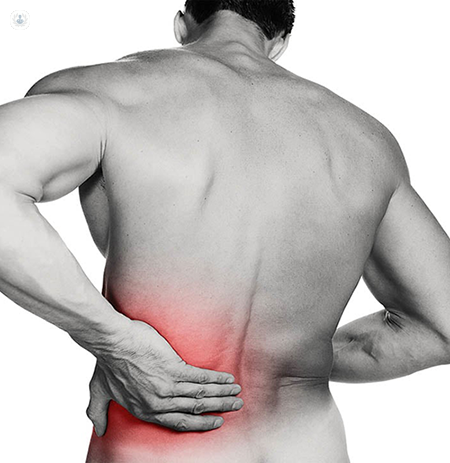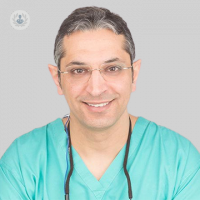Herniated disc: what is it, and why does it cause sciatica and lower back pain?
Written by:A herniated disc can result in sharp pain or numbness, and have a significant impact on quality of life. It's important to look at the causes of this, and we speak to leading consultant orthopaedic spinal surgeon Mr Khalid Salem all about it in this informative article.

The structure of the spine is such that soft pads (discs) sit between the vertebral bodies (the bone) to allow movement and help absorb shocks while walking or running. The pads have a unique structure that allows them to retain a moist “well hydrated” core (nucleus) which is then protected with a strong ring of tissue around it (annulus). Why discs degenerate remains the topic of substantial debate but it is thought that patients with extensive degeneration poses a gene that predisposes them to it while the vast majority of patients with localised disc degeneration get it as a result of long-term use (a combination of age and activity). When localised, disc degeneration usually affects the lower part of the lumbar spine (the lower back) as its anatomy and nature of the wait going through it makes it a more predictable target for this process.
Disc herniation is one end of the spectrum in disc degeneration. When it happens, parts of the softer (nucleus) comes out of its housing and sits in the spinal 'canal' where the nerves live. As the nerves are not used to such presence, they can be affected in a couple of ways; direct “mechanical’ pressure due to the fragments extruded and chemical irritation by the material within the extruded disc.
The affected nerve responds in a number of various ways affecting both the back and the leg at the side of the herniation. The back symptoms are usually non-specific and usually don’t give an indication the location of the nerve affected the leg symptoms are much more specific and helps with confirming the herniation location. In the back, the symptoms are mainly pain and spasms but the leg symptoms can range from pain/cramps to sensory symptoms (numbness and/or tingling) to weakness and the distribution of these symptoms is a good indicator of the herniation location.
The gold standard investigation for this condition is an MRI (Magnetic Resonance Imaging).
It's important to understand that the natural history of disc herniation is favourable in the vast majority of the patients with symptoms resolving in 60 per cent of the patients at three months while 90 per cent will get better by six months. The treatment initially aims to support the patient through the natural history process to try and avoid a surgical intervention. The treatment is usually based in medication and physiotherapy in the first instance to 'calm the nerve down' which the body is dealing with the body naturally deals with the herniation. Medication, however, can have side effects and might not be effective in all patients.
The use of a steroid injection around the affected nerve root is the next step in the treatment ladder and is effective. The duration of the effect is variable and its long-term success is around 60 per cent. Because of its low risk profile, patients opt to have it as a first 'invasive' step before committing to a surgical intervention.
When is surgical treatment recommended?
Surgery is considered if the patient fails to respond to less invasive interventions such as medication, physiotherapy and steroid injections and ideally after the natural history process described above was exhausted. With this in mind, all treatment options will be discussed with the patient and treatment strategy modified based on thorough discussion with the patient and joint agreement on what is a patient specific approach.
Some patients make the choice to go for herniated disc surgery early for a variety of reasons and as long as the patient understands the options and risk, this is not unreasonable.
There are situations where the surgeon might choose to recommend early surgery and these are centred around the clinical picture of the patient at presentation; progressive weakness and situations where a large disc herniation is affecting both legs and/or the bladder and bowel function are best managed surgically and quickly to presence residual nerve function and help improve the chances of recovery of what’s lost.
What is the surgery for a lumbar disc hernia?
The surgical treatment of a lumbar disc herniation aims to remove the pressure of the affected symptomatic nerve. This can be achieved through creating a window in the bone over the nerve affected to improve the space available to it, and then removing the disc extrusion in some of the cases.
Several techniques have been developed to perform a herniated disc operation. While removing the pressure of the nerve is the primary aim, achieving this with the smallest amount of disruption possible through a minimally-invasive approach that allows quick recovery and early return to activity is the current standard of practice.
Microsurgery - Discectomy
The operation is performed under a general anaesthetic. The incision is carefully placed over the area of the herniation. The surgical microscope is key in gaining superior visualisation through a small incision without compromising outcome. A window through the bone and the ligaments of the spine is created to allow access to the herniation. This allows the excision of the extruded disc fragments.
It is important to point out that only loose and extruded fragments are removed but the disc contents are not emptied as residual disc will still be critical for maintaining the motion of the affected segment.
The surgery takes 60-90 minutes and the patient is ready for discharge within 12 hours from surgery. Post-operative instructions on activity and wound care is provided prior to discharge home.
What are the complications of lumbar disc herniation?
An informed consent process in vital before embarking on any surgical intervention and that certainly holds true in spinal surgery, although the large majority of the interventions are without complications, a number of complications have been reported in the literature and form the basis of risk understanding 'decompression/discectomy' surgery.
Surgery is effective in relieving leg pain with 95 per cent of the patients experiencing significant improvement in pain whoever, back pain is less reliability improved with 70 per cent of the patient’s reporting improvement while numbness recovery is unpredictable. Tingling in the leg reliably improve with the pain and any progressive weakness will stop progressing but established weakness recovery will depend largely on the residual capacity of the nerve to heal after the surgery.
Other risk relating to the surgery include; wound infection (0.4-3 per cent), blood clots to legs or lungs in <1 per cent, nerve injury in less than 1 in 300 patients that can result in:
- permanent numbness;
- weakness;
- paralysis;
- incontinence,
- no improvement in symptoms (5 per cent);
- recurrent disc herniation (8 per cent).
Book a consultation with Mr Khalid Salem via his Top Doctors profile.


